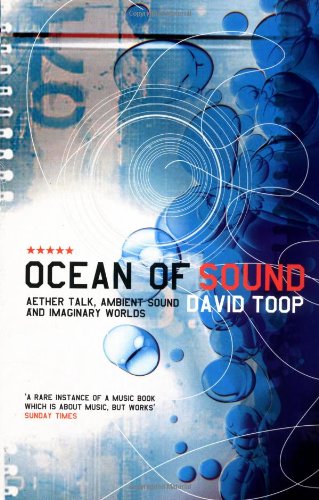
Will Johnsen loaned me this book after an interesting conversation we were having about music, copyright, and collage, amongst other things. One of us had mentioned David Toop — I can’t recall which — and it turned out that we both were fans of his stuff. Will really liked his books, but hadn’t heard his music, and I really liked his music, but hadn’t read his books! So, I burned him a disc providing a sampling, including the first Flying Lizards album, the first couple Frank Chickens albums, and his General Strike project with Steve Beresford. In return, he loaned me this book.
I don’t know if Will’s had a chance to listen to that stuff yet — I figure he’ll dig it — but I found that Toop’s as good a writer/thinker as he is a musician/producer. Ocean Of Sound is absolutely absorbing; Toop is definitely talking about subjects he knows backwards and forwards, and he interviews lots of kingpins in the various musical genres he’s talking about. Brian Eno makes a huge contribution and is witty, intelligent and engaging as usual, and the interview with Kraftwerk is, well, surprising in its existence! It’s also interesting to read one of the few times that Ralf & Florian have spoken about their music, their influences and their histories. It’s a relatively brief interview, but considering that they’ve been more-or-less silent (aside from the very, very occasional album or EP) for about 20 years, even a “No comment” would be greeted by a slackjawed expression.
The interviews with musical creators aren’t the only draw to the book. Toop’s own experiences (such as the engaging extended story of his trip to Amazonia to record the sounds of the Yanomami) are interesting, moving and amusing; like the time he records a special, high-speed news-shouting type of conversation between Yanomami, which is interrupted by the interpreter, since the “news” is about how dumb the foreigners are to want to record their music, and they’ll be able to scam some great gifts from them.
John Cage, among many others, is a frequent spectre of the book. His famous piece 4’33” is, in a way, at the center of this book. The musicians featured — as well as the music featured — all explore the relation of music to the surrounding auditory landscape, and often feature heightened listening of these outside sounds at their core. Silence itself — or rather, absolute silence and the question of whether or not it can exist — is another major theme of the work. Aside from being deaf, can we actually hear perfect silence? Even with no whirring, humming of the everpresent machinery that make up modern life (nor the chirping, buzzing of nature), we can still hear, for example, the pulsing of our own circulatory system.
The interesting thing is that Toop also explores genres you wouldn’t typically think of in terms of ambient — jazz is heavily featured as well (and not just Sun Ra, who gets a whole chapter). The point isn’t “ambient” or “new age” as people think of it, but, again, music that is part of the already existing soundscape. Music that reacts and meshes with it, rather than ignores and tries to over power it. One of the common themes that runs through the musician interviews is the idea of trying to play along with nature. People going into gardens and trying to play the same riff of water dropping into a pond. People making beats based off transportation. People programming music based on natural ebbs and flows. The titular metaphor of the Ocean Of Sound perfectly underlines of everything Toop — and his subjects — talk about. It’s also an apt descriptor of the world we live in.











